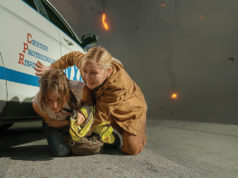The prospect of a four-and-a-half hour film about Ernesto “Ché” Guevara is enough to make everyone quail except unreconstructed Latin American Communists and the hardiest cinephiles. This is true even though it’s directed by Hollywood hand Steven Soderbergh and even though it’s been broken into two more digestible halves of roughly 2 hours and 15 minutes each. (The Modern Art Museum of Fort Worth is showing it over successive weekends; Part 1 screened last week, but it’s available via video on demand.)
There really isn’t that much to fear from it, though the film is no masterpiece, as some critics have claimed. The academic in me found the second half of the film an oddly watchable failure, but ordinary moviegoers will likely agree with the rest of me and prefer the more accessible first half.
The film skips over Guevara’s youth and begins with the Argentinian revolutionary and former medical student (Benicio Del Toro) attending a dinner party in Mexico City in 1955 to meet Fidel Castro (Demián Bichir, a Mexican actor doing a dead-on impersonation of Comrade Fidel in his youth). They spend the next few years – or the rest of Part I, if you prefer – planning and executing the takeover of Cuba.
Much like Gus Van Sant, Soderbergh has spent this decade turning out just enough commercial hits for Hollywood (Erin Brockovich and the Ocean’s films) to fund his experimental projects like the micro-budget murder mystery Bubble and the Hollywood satire Full Frontal. Surprisingly, Part I of Ché lands squarely between these poles of Soderbergh’s work. This conventional epic covers the overthrow of the corrupt Batista government, as the rebels move from remote outposts in the jungles of eastern Cuba to street-by-street fighting in the western city of Santa Clara, the last stronghold before Havana. The unfussy, self-assured combat scenes include a superb 15-minute climactic sequence in Santa Clara, where the rebels derail an army train, blow up a tank, and exchange gunfire with Batista’s dwindling troops. These are intercut with flash-forwards to Guevara’s 1964 visit to New York, in which he delineates his beliefs in a speech at the United Nations and in a TV interview. This revolutionary philosophy is packaged with enough action to keep history-averse moviegoers from squirming in their seats.
The same can’t be said for Part II, which picks up in 1966 in the dreary 11 months before Guevara’s death in the mountains of Bolivia, where he presides over a reign of error while trying to foment another revolution. Whereas Part I shows Guevara winning over the Cuban peasantry and coolly keeping his own men in line, Part II shows him alienating the head of Bolivia’s Communist party (Lou Diamond Phillips), turning a blind eye to the miscommunications between the native Bolivian soldiers and their Cuban commanders, and having his men steal food from the very farmers he’s supposed to be fighting for. His soldiers are reduced to a ragged bunch of starving, disease-ridden stragglers getting picked off a few at a time by Bolivian Army patrols, and Guevara’s ultimate execution is a sad, ignoble foregone conclusion.
Intellectually, this makes a great deal of sense. The prolonged and miserable denouement counters the heroic treatment of Guevara from Part I and helps the movie as a whole serve as a metaphor for the fate of Communism itself: splendid early triumph followed by calamity and ruin. Many of the scenes depicting failure in Part II mirror similar scenes depicting success in Part I. This gives the film exquisite structural balance.
From a moviegoing standpoint, however, it’s awfully tough to sit through. The action seeps away, the Bolivian setting doesn’t have the visual luster of the film’s Cuban half, and the monotony is only punctuated by a strange cameo appearance by Matt Damon as a Spanish-speaking German priest. We don’t need two hours of Guevara moving his base camp for no reason, ordering his troops into ambushes, and wheezing from his asthma to get the point that his Bolivian adventure was a fiasco. A more economical treatment might have spoiled the film’s formal perfection but would have given the movie more than enough power to make up for it.
Ché remains a much better accounting of its subject than the airy and prettified 2004 movie The Motorcycle Diaries. (The new biopic is also probably better than Che!, the 1969 Hollywood film starring Omar Sharif and Jack Palance, which is reported to be unbelievably bad.) Most people know Guevara as an icon from posters and T-shirts; Soderbergh’s Ché brings the man’s strengths and considerable defects to life. It’s no surprise that critics, Oscar voters, and the public have embraced Van Sant’s infinitely more humane Harvey Milk as their cinematic revolutionary of the season. Still, Soderbergh’s Guevara is engaging enough on his own terms.











